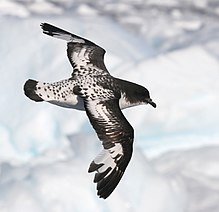| Procellariidae | |
|---|---|

| |
| Cape petrel (Daption capense) | |
| Scientific classification | |
| Domain: | Eukaryota |
| Kingdom: | Animalia |
| Phylum: | Chordata |
| Class: | Aves |
| Order: | Procellariiformes |
| Family: | Procellariidae Leach, 1820 |
| Genera | |
|
Macronectes | |
| Diversity | |
| 16 genera, 99 species, of which 3 are extinct | |
The family Procellariidae is a group of seabirds that comprises the fulmarine petrels, the gadfly petrels, the diving petrels, the prions, and the shearwaters. This family is part of the bird order Procellariiformes (or tubenoses), which also includes the albatrosses and the storm petrels.
The procellariids are the most numerous family of tubenoses, and the most diverse. They range in size from the giant petrels with a wingspan of around 2.0 m (6 ft 7 in), that are almost as large as the albatrosses, to the diving petrels with a wingspan of around 34 cm (13 in) that are similar in size to the little auks or dovekies in the family Alcidae. Male and female birds are identical in appearance. The plumage color is generally dull, with blacks, whites, browns and grays. The birds feed on fish, squid and crustacea, with many also taking fisheries discards and carrion. Whilst agile swimmers and excellent in water, petrels have weak legs and can only shuffle on land, with the giant petrels of the genus Macronectes being the only two species that are capable of proper terrestrial locomotion. All species are accomplished long-distance foragers, and many undertake long trans-equatorial migrations. They are colonial breeders, exhibiting long-term mate fidelity and site philopatry. In all species, a single white egg is laid each breeding season. The parents take it in turns to incubate the egg and to forage for food. The feeding area can be at a great distance from the nest site. The incubation times and chick-rearing periods are exceptionally long compared to other birds.
Many procellariids have breeding populations of over several million pairs; others number fewer than 200 birds. Humans have traditionally exploited several species of fulmar and shearwater (known as muttonbirds) for food, fuel, and bait, a practice that continues in a controlled fashion today. Several species are threatened by introduced species attacking adults and chicks in breeding colonies and by long-line fisheries.